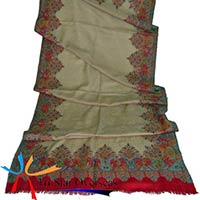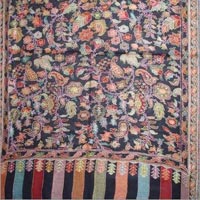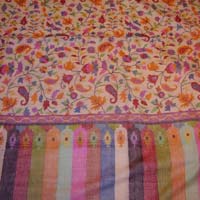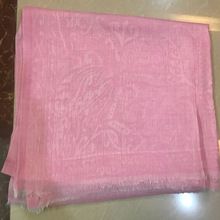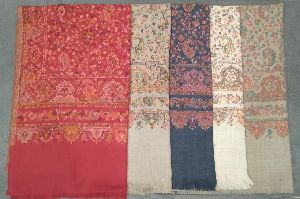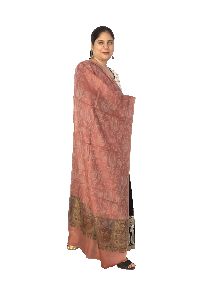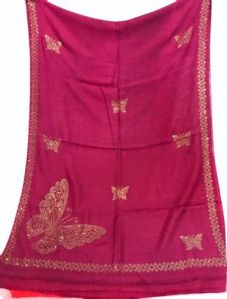Listing ID #186961
Company Information
Ask for more detail from the seller
Contact SupplierWe are one of the principal Kashmiri Kani Shawls Manufacturers. Kani shawl is a length of intricately woven material used as a wrapper around the body. The shawl is widely known as Jamawar as the kings and countries used to buy it by the yard, war and made "Jama" gown or robe out of it. It has a superfine texture which baffles even the connoisseurs. Immensely impressed by its resilience, the Emperor Napoleon presented a shawl to his Empress Josephine in 1776. This was so liked by the warrior's wife that it set a trend of new fashion in the whole of Europe. The craft is believed to be indigenous to Kashmir. It was considered as the imperial prestige, hence given an immense amount of patron Cashmere Handicrafts is prominent cashmere shawls manufacturer and cashmere Pashmina shawls exporter, presenting Kashmiri shawls. Kashmir shawl is one of the most cherished acquisitions in the world. It is believed to be indigenous to Kashmir. Experts opine for it being as old as 3,000 years B.C the period which is attributed to Neolithic age. It adorned the Ceaser's court and was looked upon by Mughals and later by Nawabs as a mark of novelty. By way of techniques, the Kashmir shawl can be categorized in two main types- the loom woven or Kani shawls and the needle embroidered or sozni shawls. Kani is the Kashmiri name given to a wooden spool which works most while weaving a shawl on the loom. Weaving is meticulously regulated by a coded pattern, known as the Talim drawn by the Naqash for guidance of the weaver.
The needle wrought design of the shawl called Sozen Kari was introduced during Afgan rule by an accomplished Kashmiri craftsman Hamid Ali Baba. The embroidery however, is exquisite and is done in a variety of designs, mainly floral. Badam or Almond with subtle stylization often forms the dominant motif which sprang of local flowers and the Chinar leaf etc., also recur in embroidery patterns. Other types of the Kashmiri Shawl are hook embroidered and generally cater to a relatively lower purse.
The finest shawls are those of Pashmina and though banned by the Central Govt. For the reasons of Wild Life Protection, Shahtoosh, a super soft variety meaning" the King of Wools". As a matter of fact it is not embryo by the extraction of which the shawl is woven. It is the under fleece of a mountain goat (with its habitat in Ladakh and Central Asia) shed by it on the high altitudes during winter months which is used for making of the shawls.
Kashmir Shawl which had once taken the entire Europe by a storm is now mostly sold in domestic market. There is however, a trend that speaks of the shawl exports having come up again. The figure has crossed Rs 240 crores during 2005-06.
Pashmina is the name of the finest hand made woolen fabric made from the soft, downy undercoat that grows primarily on the neck and belly of the Himalayan Mountain goat, Capra Hiracus. Therefore Pashmina is Pashm in woven form. The word Pashm is an adjective of a Kashmiri word 'Posh', meaning the animal. In the nage by Akbar, the great Mughal King. The miniature paintings and portraits show the Emperor wearing robes and gowns made of Kani shawl, thus pointing towards his being the great admirer of the art.
Artisans of tremendous skill and patience go to the loom and create a marvelous piece of Kani Shawl. An unbelievable amount of concentration is required for weaving just an inch of Jamawar. An artisan can not weave beyond an inch a day while being at the loom. The Kani Shawl being oblong in shape generally remains in lx2 meters in size. Two craftsmen can complete a shawl within 2 to 3 years and in some cases the period of weaving even stretches to 5 long years, depending entirely on designs. The traditional Kani shawl of the value of Rs 2lakh and above can be woven in the length of lx2 meters in which the low cost of Rs 30000/- only can also be produced depending on variety of the designs and material. Kanihama, a village in western part of Kashmir, has monopolized the weave and trade of Kani Shawl. The village has found its name on this monopoly of the shawl, kani as it is obvious refers to wooden spool and hama the village. The craft had died during early decade of the century but got revived by the government and by the private concern in a small way. There are about 300 looms operative in Kanihama doing their best to keep the tradition alive.
The most exploited of motifs in Kani Shawl is the mango shaped almond, known as badam in local parlance. Kairy is the Hindi words for mango, hence the reason for fame that the motif has found in India under it. Some equate it with "Paisley" motif because it could not avoid the influence of that fabric of that part of Scotland.
It is also known Shawl-Tarah (Shawl pattern) for it often recurs in the Kani Shawl with constant change that gradually occurred in the motif. It also came to be known as Saraw (Cypress) as having great similarities to that shrub. Whatever be the name, the stylization of the craftsmen only points to the unlimited characteristics of the Kashmiri ornamentation.
The Kani Shawl refers to a particular type of shawl that is woven using numerous eyeless wooden spokes in the place of a shuttle. These spokes are traditionally called 'Tuji's' or 'Kanis', meaning eyeless in Kashmiri language. The technique of Kani Shawl weaving has been termed as the 'twill tapestry weave' (1) by Sir John Irwin, keeper at the Victoria & Albert Museum, London, and a well known researcher on the subject, because of its similarity to the technique traditionally employed in Western Europe for tapestry weaving.
The Kani shawl has been historically produced using fine hand spun Pashmina & Shahtoosh (5) fibres which have further added to its richness and earned it the name of 'ring shawls' meaning that it can pass through a ring.


